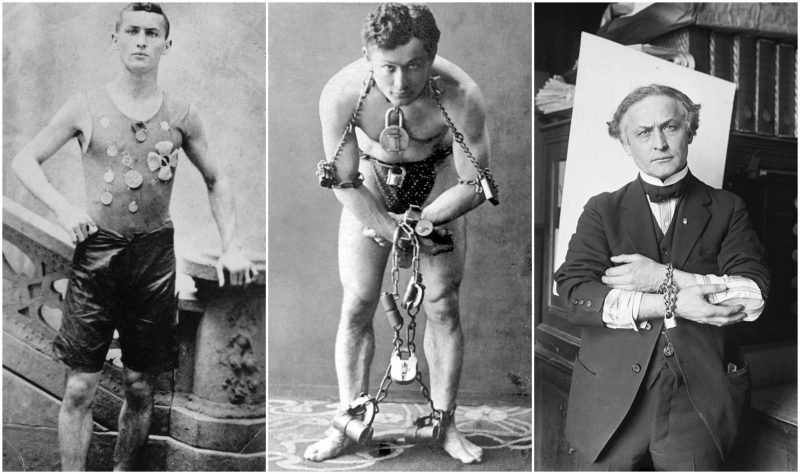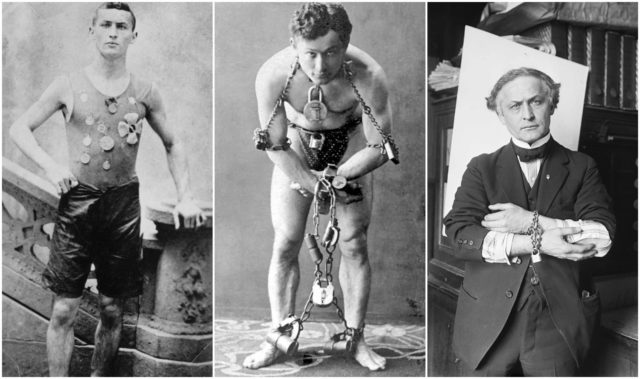
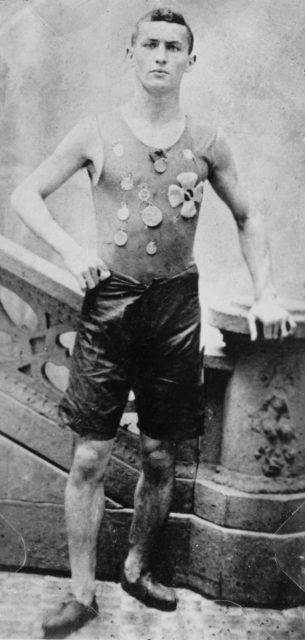
- Harry Houdini was born Erik Weisz. At the age of four, when his family emigrated to Wisconsin State, his name was changed to Ehrich Weiss. Nicknamed Ehrie (or Harry), the young Weiss had a fascination with magic, particularly with the work of a famed French conjurer named Jean-Eugène Robert-Houdin. Ehrich paid homage to his hero when he started his own magic career in the 1890s by adding an “i” to the name Houdin to create his stage name, Harry Houdini. Sadly, in a strange twist of fate, Houdini would later court controversy by accusing his former idol of stealing other magicians’ illusions. Not only that, but Houdini would write a book in 1908 about the subject, called The Unmasking of Robert-Houdin. In it, he branded his namesake as a fraud “who waxed great on the brainwork of others.”
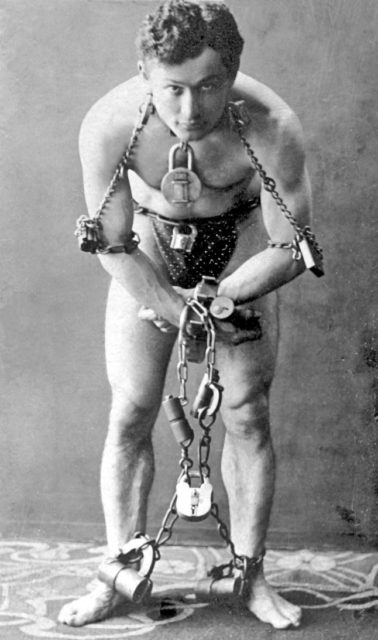
- After struggling to gain popularity, Houdini finally found fame as the “King of Handcuffs.” Up until 1899, Houdini had opened a magic school and struggled to make it big in show business. It was only after Martin Beck, a vaudeville impresario, gave Houdini advice that Houdini’s popularity skyrocketed. On Beck’s advice, Houdini made escapes a central part of his act. He would challenge audiences to tie him up or lock him in handcuffs. Houdini promoted his shows by staging escapes from local jails—these shows required his being strip-searched and put in shackles by police. Needless to say, his routine was a huge success and he was christened “King of Handcuffs.” His shows were sold-out across Europe. His fame would be cemented after he staged several high-profile escapes in the United States. One such stunt had Houndini jump into a Rochester, New York, river with his hands manacled behind his back. In another stunt, he broke out of the jail cell that had once held Charles Guiteau, the man who assassinated President James A. Garfield.
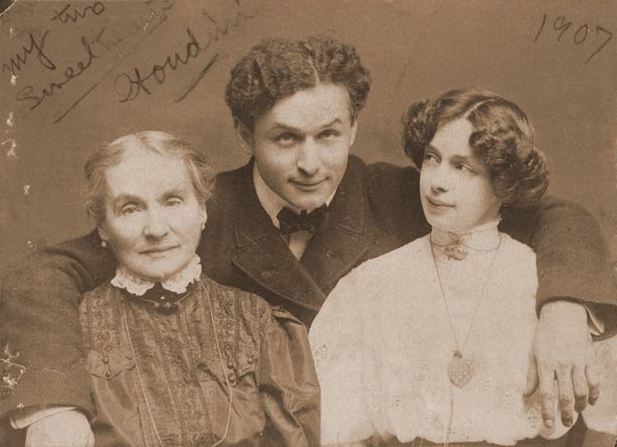
- Magic must run in families, because Harry Houdini’s brother was also a successful magician. Once he had established himself in Europe in the early 1900s, Houdini brought over his younger brother, Theo. Early in his career, they worked as partners, and when Theo could, he began performing his brother’s tricks solo under the stage name “Hardeen.” Luckily, the only rivalry the two brothers had was fake. The phony feud helped boost their profiles. “We made no secret of the fact that we were brothers,” Hardeen later remembered, “but we did keep secret not only the fact that we were good friends but that Harry had set me up in business!” Although largely overshadowed by his more famous sibling, Hardeen is now credited with having pioneered the act of escaping from a straitjacket in full view of the audience—a trick that would later became a staple of Houdini’s routine. After Houdini’s death, Theo inherited Houdini’s stage equipment and continued using it in performances into the 1940s.
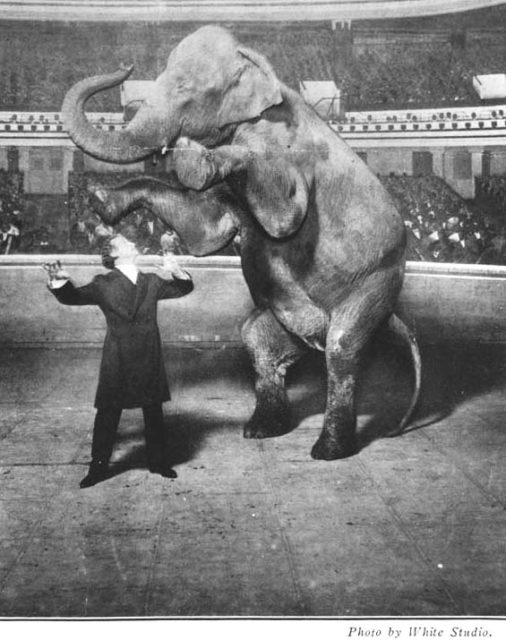
- One of the most bizarre stunts of Houdini’s career occurred when he escaped from the belly of a 1,500-pound “sea monster.” This stunt came about in September 1911 when a group of Boston businessmen challenged Houdini. The sea monster had supposedly washed up in the city’s harbor. Although, historians still aren’t sure what the creature was. It has been described as everything from a whale to a leatherback turtle. Nevertheless, the magician was up to the challenge. He allowed himself to be handcuffed, shackled in leg irons, and wedged inside the stinking carcass as thousands of spectators watched. Then the monster itself was covered in chains and placed behind a curtain. Fifteen minutes later, Houdini emerged, triumphant. He did later admit that he nearly suffocated by the fumes from the chemicals used to embalm the sea monster.
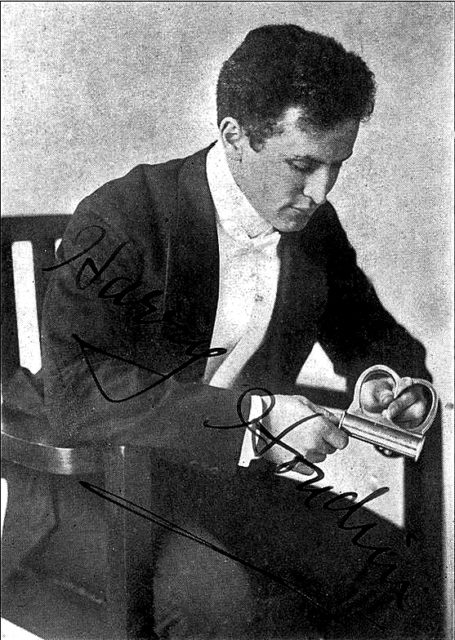
Houdini, c. 1900.Source
5.Harry Houdini wasn’t just a magician; he was also an aviation pioneer. He first developed a passion for aviation while in Europe in 1909. Later, he would buy a French-made Voisin biplane and became one of the world’s first private pilots. Unfortunately, he crashed during his maiden flight in Germany, but that didn’t deter the magician. After practicing consistently, Houdini set his sights on becoming the first man to pilot an airplane in Australia. In March 1910, during a tour, Houdini got behind the controls of his Voisin and made three successful flights near Melbourne, each only a couple of minutes long. At the time, the Aerial League of Australia certified Houdini’s display as the country’s first powered and controlled flight. However, some historians have since argued that the record actually belongs to Colin Defries. Defries was an Englishman who had made a brief flight a few months earlier. In 2010, Houdini and Defries were both honored in a series of stamps commemorating the centennial of powered flight in Australia.
- Although Harry Houdini was born in Hungary, he assisted with the American war effort during World War I. Having spent most of his life in America, he was a staunch patriot and supported the U.S. involvement in the war. Houdini convinced the Society of American Magicians to sign oaths of loyalty to President Woodrow Wilson. He even cancelled his touring season in order to devote himself to entertaining soldiers and raising money for the war effort. Furthermore, he drew on his arsenal of magicians tricks to provide special instruction to American troops. For example, in a series of classes held at the Hippodrome in New York, Houdini taught doughboys how to escape sinking ships and free themselves from ropes, handcuffs, and other restraints in case of capture by German troops.
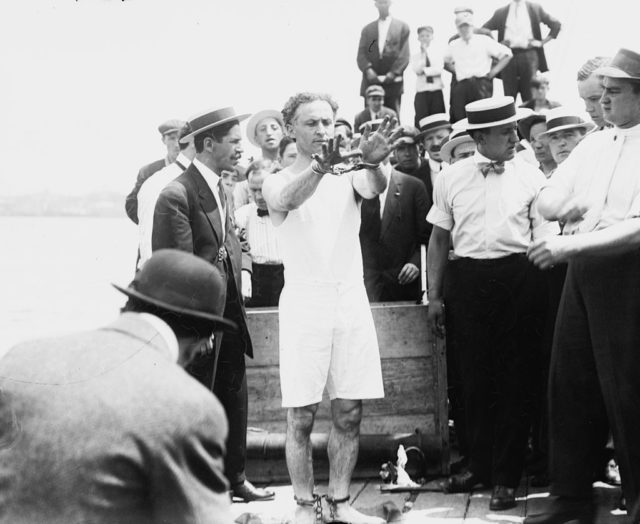
Houdini prepares to do the overboard box escape c. 1912 Source
- Houdini had a brief career in silent film. This short stint began in 1919 with the movie The Master Mystery, an adventure serial in which Houdini played an undercover agent who uses his escape skills to foil criminal plots. The series was a hit and it is now remembered as the first film to feature a robot. Houdini would go on to star in two more features before going on to launch his own movie studio called The Houdini Picture Corporation. The company made two films: The Man from Beyond and Haldane of the Secret Service. Neither, however, fared particularly well at the box office—critics mocked Houdini’s stilted performances. After losing a large chunk of his personal fortune, he quite the movie business in 1923.
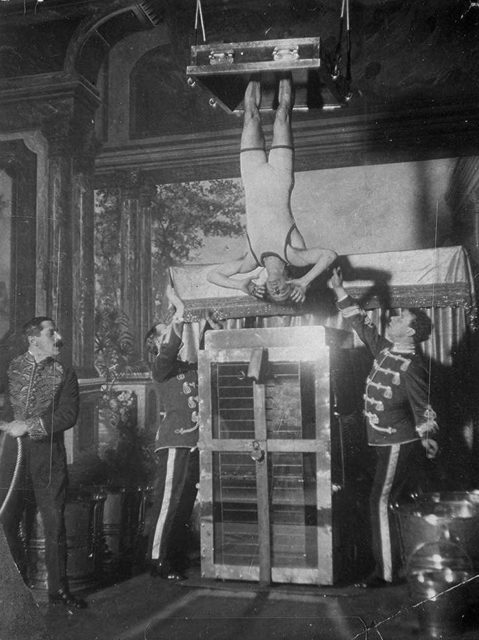
- Despite being the world’s greatest trickster and illusionist, Houdini went out of his way to debunk psychics and the supernatural. He had little patience for people who claimed to be in possession of supernatural abilities. Starting in the 1920s, Houdini began a second career as a professional skeptic and debunker of psychics, mind readers, mediums, and other Spiritualists—basically anyone who claimed to be able to contact the deceased. The magician campaigned tirelessly. He visited séances whilst in disguise in an attempt to expose their ringleader as frauds. A $10,000 was offered by Houdini to any psychic who could present physical phenomena that could not be explained rationally. Perhaps unsurprisingly, no one ever collected the reward. His conviction was so strong that in 1926, he testified before Congress in support of a bill to outlaw the practice of “pretending to tell fortunes for reward or compensation.”
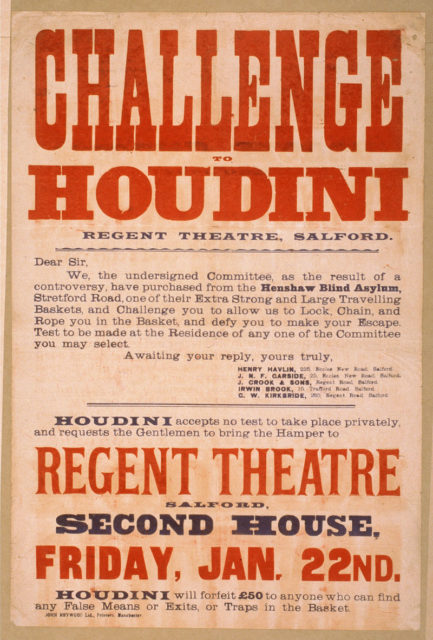
- Harry Houdini died on Halloween 1926 at the tender age of 52. Just days before, he struggled through a final performance in Detroit. The official cause of death: peritonitis that was brought on by a ruptured appendix. However, as with any popular figure, several legends surrounding his death have sprung up and continue to make the rounds today. One of the most famous concerns in incident that occurred after a performance in Montreal on October 22. In his dressing room, Houdini was approached by a university student who asked about a rumor that the magician could withstand heavy punches to his abdominal muscles. After Houdini boasted about his physical strength, the young man gave him a blow to the stomach without warning. Houdini, understandably, was left doubled over in agony and complained of stomach pains for the rest of the day. This has led many to conclude that the unexpected punch somehow triggered his appendicitis. Other theories claim that Houdini was poisoned by the Spiritualists, who had previous issued several death threats against him in response to his criticism.
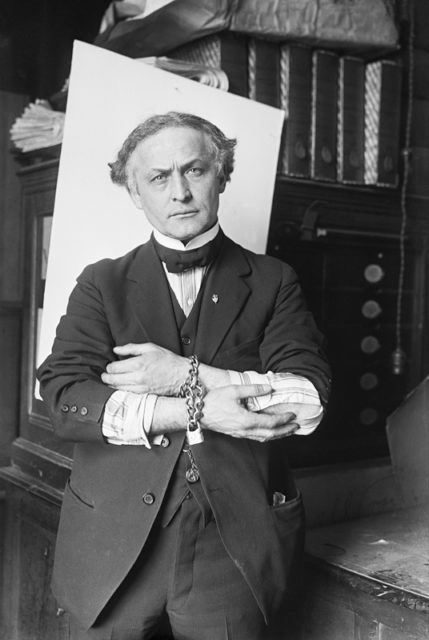
Houdini Showing How To Escape Handcuffs Source - True love knows no bounds. In spite of his skepticism about the spirit world, Houdini swore to Bess, his wife, that he would try to contact her from beyond the grave. He instructed her to listen for a specific message, a series of codes that spell out the words “Rosabelle, believe.” Bess Houdini would spend a decade trying to contact her husband. She eventually gave up, supposedly saying, “ten years is long enough to wait for any man.” Others, more stubborn, continued the search. Since the 1930s, fans have held séances for Houdini every Halloween to communicate with the deceased magician. There is even an “Official Houdini Séance” that takes place in a different city each year.
